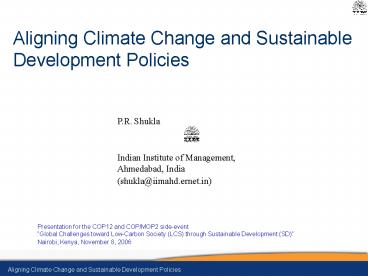Low Carbon Society - PowerPoint PPT Presentation
Title:
Low Carbon Society
Description:
Title: Low Carbon Society Author: P.R. Shukla Last modified by: hcl infosystem Created Date: 7/22/2004 6:58:38 AM Document presentation format: On-screen Show – PowerPoint PPT presentation
Number of Views:69
Avg rating:3.0/5.0
Title: Low Carbon Society
1
Aligning Climate Change and Sustainable
Development Policies
Presentation for the COP12 and COP/MOP2
side-event Global Challenges toward Low-Carbon
Society (LCS) through Sustainable Development
(SD) Nairobi, Kenya, November 8, 2006
2
Why should Development and Climate actions be
aligned?
- Climate change is a derivative problem of
development - Development is the key to mitigative and adaptive
capacities - Dealing with climate change exclusively is very
expensive expected to cost several trillion
dollars over this century - Strategies for dealing with sustainable
development and climate change have many common
elements, and aligning these would deliver
co-benefits
3
Aligning Development and Climate by Shifting the
Frontier
- Overcoming Conflict by Shifting the frontier
though - Innovations in technology institutions
- Targeted technology innovations, investment and
deployment - Aligning diverse interests of multiple
stakeholder - Sequence of policies and measures to accrue
co-benefits - International and regional cooperation
4
Mainstreaming Climate Change in National
Development
MDG, Indias National Targets and Climate Change
MDG and global targets Indias National plan targets Interface with Climate Change
Goal 1 Eradicate extreme poverty and hunger Targets Halve, between 1990 and 2015, the proportion of people with income below 1 a day and those who suffer from hunger Double the per capita income by 2012 Reduce poverty ratio by 15 by 2012 Contain population growth to 16.2 between 2001-2011 Income effect would enhance choices for cleaner fuels and adaptive capacity Reduce GHG Emissions due to lower population
Goal 7 Ensure environmental sustainability Targets Integrate SD principles in country policies/ programs to reverse loss of environmental resources Target Halve by 2015 the proportion of people without sustainable access to safe drinking water Increase in forest cover to 25 by 2007 and 33 by 2012 (from 23 in 2001) Sustained access to potable drinking water to all villages by 2007 Electrify 80,000 additional villages by 2012 via decentralized sources Cleaning of all major polluted rivers by 2007 and other notified stretches by 2012 Enhanced sink capacity, reduced GHG and local emissions lower fossil imports reduced pressure on land, resources and ecosystems Higher adaptive capacity to from enhanced supply of water, health education in rural areas
5
Influencing Energy Transitions
How to transit to Modern Biomass? Food Security?
Domestic Resource ve Direct Employment ve
Energy Security -ve Foreign Exchange -ve
En. Security Ve
Fuel Supply? Waste disposal? Safety?
Geopolitical Risk High Foreign Exchange -ve
Regional water disputes? Indirect Benefits
6
South-Asia Energy Cooperation
- Spillover Benefits
- 16 MW additional Hydropower
- Flood control
- Lower energy prices would enhance competitiveness
of regional industries
Benefit (Saving) Cumulative from 2010 to 2030 Benefit (Saving) Cumulative from 2010 to 2030 Billion GDP
Energy 60 Exa Joule 321 0.87
CO2 Equiv. 5.1 Billion Ton 28 0.08
SO2 50 Million Ton 10 0.03
Total Total 359 0.98
7
CO2 Emissions Saved by Electricity Reforms
Baselines of Carbon Content of Electricity
8
Sustainable Development Climate Impacts on
Infrastructure
9
Conclusions
- Opportunities to mainstream climate concerns in
development actions exist everywhere and more so
in developing countries. - Climate centric actions could miss opportunities
which may deliver development and climate
co-benefits. - Pathways to Low Carbon and Climate Resistant
societies are best found if viewed through the
sustainability lens. - Cost-effective transition to Low Carbon Society
is not automatic. It would require crafting
strategies that align development and climate
policies and actions through sustainability goals.

